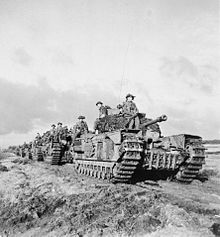History of the Scots Guards (1914–1945)
The regiment saw further involvement in the bitter cold month of December, and in that month, on 19 December, Private James Mackenzie of the 2nd Battalion won the regiment its first Victoria Cross (VC) of the war, and the first VC won by the Scots Guards, rather than its predecessor name, the Scots Fusilier Guards.In March 1915, the 2nd Battalion took part in the Battle of Neuve Chapelle, which was a relatively successful engagement, though it did fall short of its expected gains of advancing all the way to Lille.With no regard for his safety, Lieutenant Boyd-Rochfort shouted to the men to look out, and subsequently rushed to the bomb, grabbed it and duly threw it over the parapet where it instantly exploded.Both battalions continued to experience heavy fighting throughout September, and into October, and by the end of the Battle of Loos, the regiment had suffered over 500 casualties.On 15 July, Lance-Sergeant Frederick McNess of the 1st Battalion, led a bombing party under very heavy shell and machine-gun fire.Despite the severe wounds the Sergeant subsequently made a 'block', encouraged his men and continued to throw grenades until eventually succumbing to the loss of blood.The Sergeant subsequently reorganised the company and upon noticing a counter-attack developing, he successfully repulsed it by skillfully exploiting machine-guns to his advantage to inflict very heavy casualties on the German attackers.Sergeant McAulay also carried a considerable distance to a safer location, while under heavy fire, the mortally wounded company commander.For his actions Corporal Wood was awarded the Victoria Cross, the last VC won by the regiment during the First World War.Both battalions would remain in the United Kingdom for the majority of the inter-war years where it carried out the usual public duties, though would, at times, be deployed abroad.In 1935, it was the 1st Battalion's turn to be deployed abroad when it was stationed in Egypt during the tense times between the British Empire and Italy, after the latter had invaded the East African nation of Abyssinia.The 24th Guards Brigade was then used to protect a number of Norwegian ports from German attack, though all fell by the end of May, and, due to the troubling situation in France, the British Army began evacuating from Norway, which was completed by 8 June.In May, the regiment saw action at the Battle of Halfaya Pass, which saw British and Commonwealth forces experiencing tough fighting against Erwin Rommel's Afrika Korps.Between October and November the Second Battle of El Alamein took place, which saw General Montgomery's British Eighth Army achieve a decisive victory over the German, which saw them go into full-retreat.In North Africa, on 6 March, the 2nd Battalion took part in the defensive Battle of Medenine, after the Germans had counter-attacked the Allies, an attack that, if it had succeeded, would have caused the British many problems.During that month, Captain The Lord Lyell of the 1st Battalion, commanded a company with great dash and valour during engagements between 23 and 27 April, taking part in tremendously heavy fighting against German forces and kept the morale of his troops high.The regiment, as in the First World War, proved its professionalism once more, seeing service in North Africa, Italy and across North-West Europe, taking part in some of the British Army's most famous moments.During the war, just over 1,000 men of the Scots Guards lost their lives and many gallantry awards were won, including a single Victoria Cross.



Scots Guards1642–18041805–19131946–presentKing Charles IArchibald Campbell, 1st Marquess of ArgyllScots Guards (1805)Archduke Franz FerdinandCountess SophieFirst World War1st Guards Brigade1st DivisionBritish Expeditionary ForceFirst Battle of the MarneBattle of the Aisne20th Guards Brigade7th DivisionFirst Battle of YpresRegular armyJames MackenzieVictoria CrossBattle of Neuve ChapelleBattle of AubersBattle of FestubertGeorge Arthur Boyd-RochfortparapetGuards Division2nd Guards Brigade3rd Guards BrigadeBattle of LoosBattle of the SommeBattle of Flers–CourceletteMorvalLesboeufsFrederick McNessThird Battle of YpresPilckemMenin RoadPoelcapellePasschendaeleBattle of Cambrai (1917)John McAulaysecond Battle of the SommeSt. QuentinBapaumeAlbertBattle of HavrincourtHindenburg LineCanal du NordBattle of Cambrai (1918)Harry Blanshard WoodRiver SellesnipersWestern FrontBattle of the SelleValenciennesBattle of the SambreArmisticeBritish Army of OccupationCologneJerusalemJaffa GateTower of DavidPrivateFoot GuardsGermanyShanghaiFar EastCommunistsNationalistsWinnipeg GrenadiersAbyssiniaPalestineArab Revolt13th Scottish Light DragoonsHM King Edward VIIIHis Majesty King George VIUniversal CarriersNazi GermanyBritish Empire24th Guards BrigadeNorwayHarstad30th Infantry BrigadeNorth African Campaign22nd Guards BrigadeBattle of Halfaya PassErwin RommelAfrika KorpsOperation BattleaxeTobrukAlliesOperation CrusaderSiege of Tobruk6th Guards Armoured BrigadeGazala201st Guards BrigadeFree FrenchSecond Battle of El AlameinMontgomery'sBritish Eighth ArmyTripoli6th Guards Tank BrigadeNorth AfricaBattle of MedenineCaptainThe Lord Lyell56th (London) Infantry DivisionVolturnoBattle of Monte CassinoItalian Theatrelandings at AnzioCampoleone6th South African Armoured DivisionMonte San MicheleGothic LineArgenta GapTriesteArgyll and Sutherland HighlandersNormandyMont PinconJagdpantherChurchill tanksLow CountriesRhinelandGuards Armoured Division